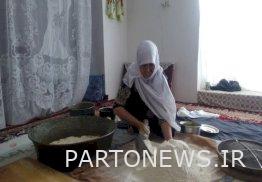Bibi Gardi An ancient and feminine ritual in Noghab Gonabad

Arya Legacy: In different parts of Iran, there are local traditions, rituals and celebrations in commemoration of Nowruz, one of these rituals that can be included as a cultural element in the collection of ancient celebrations and rituals of Iranian people in commemoration of Nowruz is Bibigardi Noughab Gonabad.
We go to Gonabad in the south of the province, a city where the aqueduct of the town of Gonabad is one of the historical monuments registered in the world heritage list. Gonabad, which is the southernmost city in Razavi Khorasan province, has many customs and rituals for Nowruz. It smells like Nowruz.
Although the ceremony is held on the 9th of Farvardin, but the preparations for it have been made since the 8th of Farvardin, one of the women of Noghab neighborhood of Gonabad city reminds that the performance of this ceremony on the 9th of Farvardin has been reserved for women. Therefore, it can be said that the Bibi Gard ceremony has a more feminine aspect, although in recent decades, men also join women in the last hours of the day. They make an exception for us to be with them to watch the event closely.
Preparation of unleavened bread
The preparation and preparation of edibles and foods for the ceremony is one of the most important preparatory parts of this ritual, in general, the edibles of Bibi Galvi (Gardi) Nougab day can be classified into three general categories: bread, food and nuts. The most important and main food that is prepared for Bibi Gurd celebration is a kind of bread, this bread is known in Noghab as “Bibi Gelo Unleavened Bread” or “Bibi Gelo Patir”.
On the 8th day of Farvardin, we go to several houses of the residents of Nougab Gonabad, there is a certain vibrancy among the residents, like an orderly army, each of them doing their own work, preparing bread and other food for the day.
The importance of the latter issue is so great that it can be considered as one of the main sub-rites of the Bibi Galvi Noghab ceremony. The reason for this importance is that this food, unlike other foods in the Bibi Gelo ceremony (with the exception of Ash Amach), is prepared in a group and along with cultural and ritual practices.
According to the residents, holding the ceremony of making Patir Bibi Gelo on the 8th or 9th of Farvardin is one of the minor rituals of the Noghab Bibi Gelo ceremony, which has never been abandoned throughout history.
On the day of Bibi Gard or the 9th of Farvardin, Noghabi women, guided and accompanied by elderly women (Bibis), leave Noghab to a specific destination known as “Pir Kaleh” where a holy shrine and an aqueduct are located next to it. .
Women in Bibi Gard mainly have fun and happiness, but it seems that the prayer, wish and ritual of this ceremony has deep roots that cooking and preparing some special foods such as Ash Amaj and a type of fatir and consuming it on a daily basis. Bibi Gard shows the ritual aspects of Bibi Gard ceremony.
One of the things that shows the human aspect of this ritual is that Noghabi women pour extra food into the aqueduct for the fish.
The weather is almost hot and the sun in the desert region of Gonabad is a bit annoying at noon, but today, fortunately, the weather is cloudy and a cool breeze is blowing. There is more excitement and cheerfulness in Pir Kalle, a variety of competitive games and other entertainments are held, the presence of men in the Bibi Gard ceremony is accompanied by stomping, clapping and happiness.
During the past years, the final part of the ceremony, in which men are also present, is held with more enthusiasm.
Registering the traditional Bibigardi ceremony of Noughab Gonabad in the list of the national intangible cultural heritage of the country
Mahmoud Taghraei, head of the office of registration of historical, natural and intangible monuments of the General Directorate of Cultural Heritage, Tourism and Handicrafts of Khorasan Razavi, says about this: Recently, the traditional Bibi Gardi ceremony of Noughab Gonabad has been registered as number 137 in the list of national intangible cultural heritage of the country.
He clarifies: In the culture of Khorasan, Nowruz programs are centered on social excitement and although this ceremony is mostly dedicated to women, at the end of the ceremony, men also join the women and a collective program is performed.
Gonabad city has 176 historical monuments registered in the list of national monuments of Iran and more than 50 tourist attractions.
The aqueduct of the town of Gonabad is registered in the world heritage list.
Gonabad city is located at a distance of 270 km from the south of Mashhad.
Report from Mohammad Ali Alinejad

